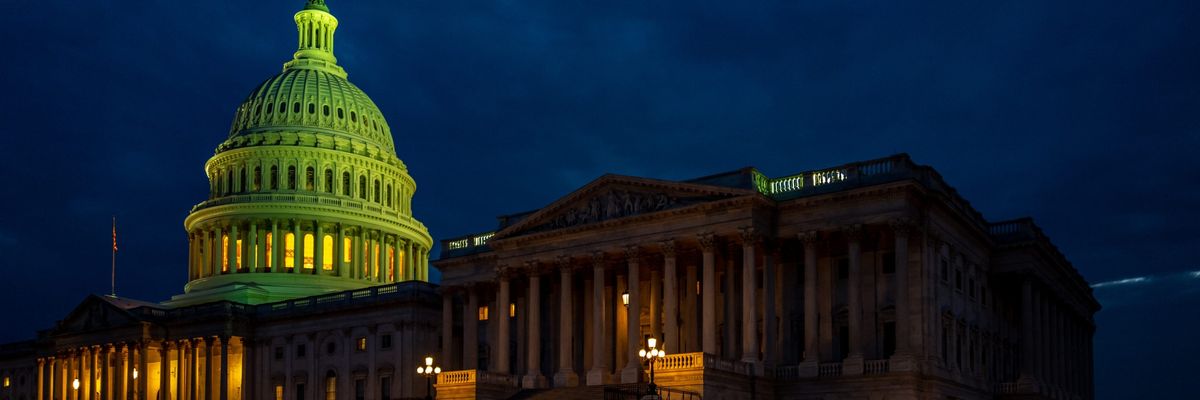Bipartisan majorities in the House and Senate this week approved a $740 billion national defense authorization bill (NDAA), setting up negotiations for a final version, which will almost certainly pose a major boon for defense contractors, passing along a tax bill that by comparison more than wipes out the average tax filer’s COVID-19 stimulus check.
The extent of the NDAA’s historical financial benefit to defense contractors is staggering, with, for example, over half of the 2019 total defense-related discretionary spending — $370 billion of $676 billion — going to contractors, according to Brown University’s Costs of War Project.
Assuming this pace continues, the 2021 NDAA could pass along more than $370 billion to defense contractors, many of whom have contributed generously to politicians, like Rep. Rob Wittman (R-Va.), the top recipient of defense contractor campaign contributions in 2018, who authored a recent op-ed making “The Case for Robust Defense Spending.”
On the other side of the aisle, Democrats who voted against an amendment to cut the military budget by 10 percent received 3.4 times as much in campaign contributions from the defense industry than those who voted for the amendment.
The NDAA and its windfall for defense contractors is particularly troubling amid the COVID-19 pandemic which has, in addition to the public health crisis, caused economic turmoil, record unemployment levels, and federal efforts to inject liquidity into financial markets.
In March, the government sought to buoy the economy and blunt the economic impact of the pandemic with “Economic Impact Payments,” more commonly known as “coronavirus stimulus payments.” According to CNBC, the average payment was $1,809 per tax filer, which could be individuals or married couples filing jointly.
The long-term benefits of that payment to tax filers are dwarfed by the costs imposed on taxpayers by the defense budget and payments to defense contractors that Congress authorized in this year’s NDAA.
The IRS anticipates 155.1 million tax returns to be filed in 2020, meaning the cost of the upcoming NDAA will be, on average, $4,711.11 per tax filer, completely wiping out the stimulus payment and imposing an additional $2,902.11 burden per filer.
Just the portion of the NDAA destined for defense contractors, $370 billion or $2,385.55 per average tax filer, wipes out the average stimulus payment and imposes a $576.55 tax burden per filer.
Even the potential Senate Republican-led second stimulus proposal won’t fully unburden taxpayers from the NDAA’s massive discretionary spending on the military and defense contractors. The proposed legislation would include a $1,200 stimulus check to some Americans. That payment, combined with the average $1,809 payment from the March stimulus, would cover the average tax filer’s portion of the NDAA costs benefiting defense contractors but would still leave them with a $1,702.11 financial burden from overall annual defense spending.
Of course, the immediate cost per-tax filer might be deferred via deficit spending, but the national debt currently exceeding $26 trillion — over $167,000 per anticipated 2020 tax filer and over $80,000 per U.S. citizen — should raise questions about the role of the defense budget, which is the second largest category of federal spending after social security, and represents more than half of the discretionary budget. Moreover, U.S. defense expenditures exceed the annual combined defense spending of China, India, Russia, Saudi Arabia, France, Germany, the U.K., Japan, South Korea, and Brazil.
That levies a large bill on taxpayers, either in immediate taxes or assumed portion of the national debt, but Lockheed Martin President James D. Taiclet was decidedly upbeat on a July 21 earnings call, in which he beamed that “our portfolio was supported” in the NDAA. He said:
"[There are] encouraging elements for our portfolio is [sic] the Senate version confirmed that the national defense strategy remains the roadmap for the armed services. And the bill was passed with strong bipartisan support. Our portfolio was well supported in the Senate version for the recommended increase of 16 F-35 aircraft above the President's request, additional funding for missile defense priorities including an 8 THAAD battery and increased funding for the Homeland Defense Radar Hawaii program. Congress will continue with the authorization and appropriation spaces. We look forward to the finalization of the process in supporting our warfighters needs."
While the “warfighters needs” are arguably not supported from a combination of endless wars in the Middle East, a ballooning national debt burden at home, and a pandemic that’s spurring unemployment levels to rise over 10 percent, there are at least two beneficiaries from the NDAA: politicians who rely on defense contractor campaign contributions and defense contractors who see “encouraging elements” for their “portfolio” from the industry’s $2,385.55 annual burden on each tax filer.














